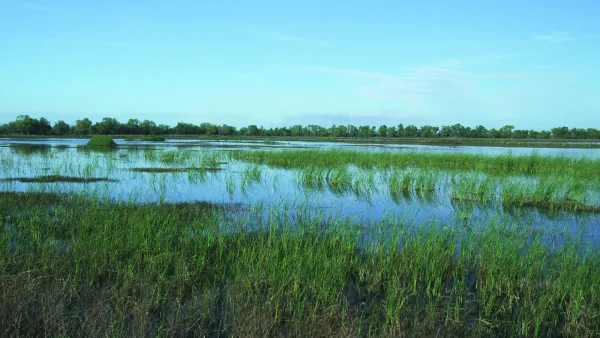Already the hottest major American city, Peter O'Dowd describes how planners in Phoenix are preparing for the increased sizzle brought on by global warming.
Global climate change and the increasing urban heat island effect of an expanding city are the twin fires stoking rising temperatures in this desert city. Although the effects of these heat problems are already being felt, the future is much more bleak. "Data from the North American Regional Climate Change Assessment Program
predict sustained heat waves above 114 degrees will be a yearly crisis
in Phoenix by 2040. And each one, researchers project, will last a
sweltering three weeks," writes O'Dowd.
As a result, city officials are planning to make Phoenix a laboratory for testing strategies to mitigate increased temperatures. Covering 25 percent of Phoenix with shade trees is one idea being considered. Building higher, and more densely is another.
In the northern part of the city, at a housing complex designed for people with lower incomes called Devine Legacy, some of these ideas are already being tested, with positive results. "Walking through the front gate leads you to a courtyard. Four-story
buildings rise up on either side of you. There's shade everywhere, and a
breeze moves through the space. Even on a 113-degree day in Phoenix, it
feels much cooler," notes O'Dowd.
"Ernesto Fonseca, a planner who specializes in sustainable
communities, helped test Devine Legacy's energy use before it opened
late last year. He considers the complex a small victory in what may someday be a more complicated effort to stay cool."
Thanks to Daniel Lippman
FULL STORY: Scorching Phoenix Plans For An Even Hotter Future

National Parks Layoffs Will Cause Communities to Lose Billions
Thousands of essential park workers were laid off this week, just before the busy spring break season.

Retro-silient?: America’s First “Eco-burb,” The Woodlands Turns 50
A master-planned community north of Houston offers lessons on green infrastructure and resilient design, but falls short of its founder’s lofty affordability and walkability goals.

Delivering for America Plan Will Downgrade Mail Service in at Least 49.5 Percent of Zip Codes
Republican and Democrat lawmakers criticize the plan for its disproportionate negative impact on rural communities.

Test News Post 1
This is a summary

Test News Headline 46
Test for the image on the front page.

Balancing Bombs and Butterflies: How the National Guard Protects a Rare Species
The National Guard at Fort Indiantown Gap uses GIS technology and land management strategies to balance military training with conservation efforts, ensuring the survival of the rare eastern regal fritillary butterfly.
Urban Design for Planners 1: Software Tools
This six-course series explores essential urban design concepts using open source software and equips planners with the tools they need to participate fully in the urban design process.
Planning for Universal Design
Learn the tools for implementing Universal Design in planning regulations.
EMC Planning Group, Inc.
Planetizen
Planetizen
Mpact (formerly Rail~Volution)
Great Falls Development Authority, Inc.
HUDs Office of Policy Development and Research
NYU Wagner Graduate School of Public Service



























